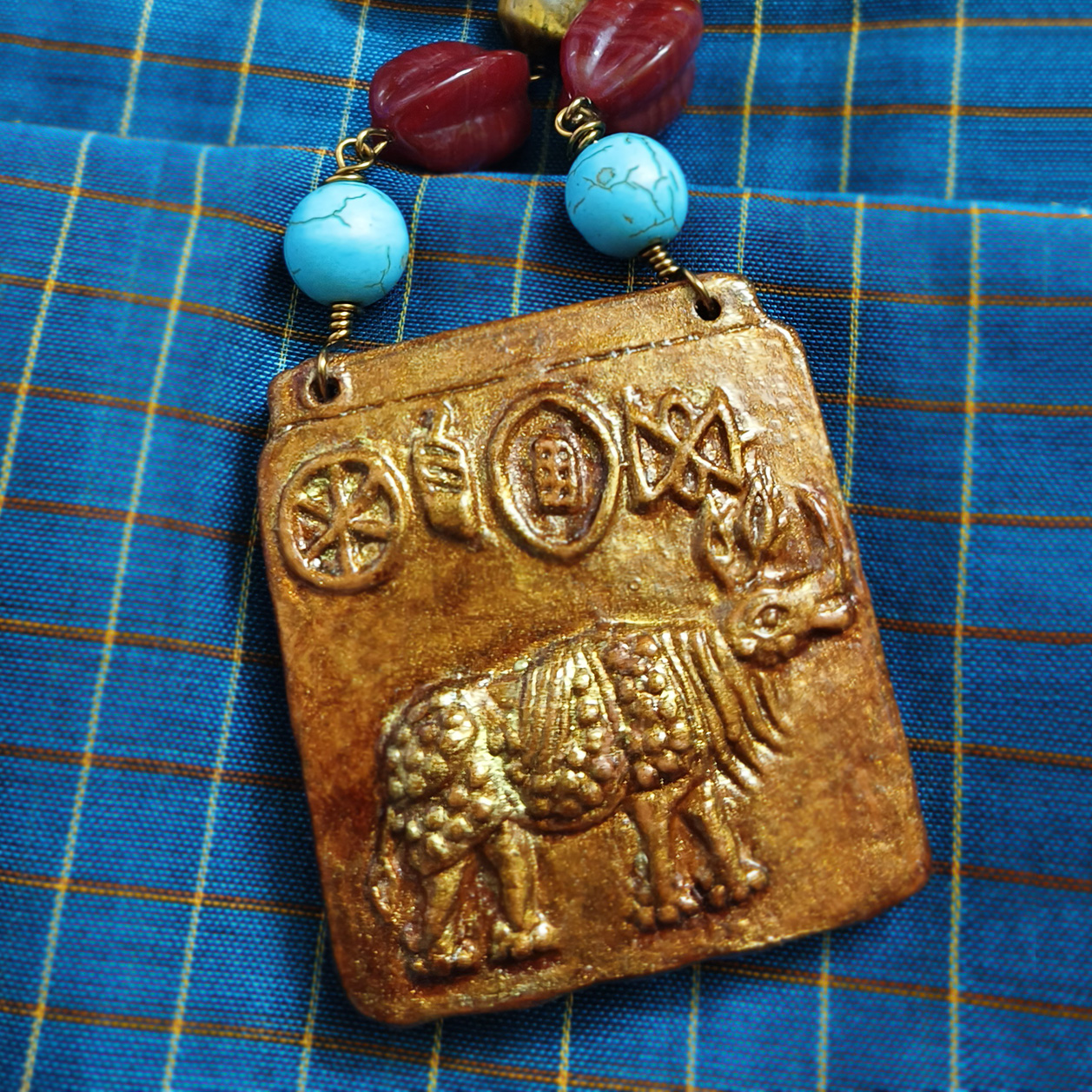When I was in sixth grade, I wanted to be an archaeologist. We had studied Indus Valley civilisation in history and I dreamt about bronze dancers draped in strands of carnelian and lapis lazuli. Adding to that lesson, was a book that I found on Indus valley scripts and seals. It opened up a world of possibilites for a child grappling with learning issues and middle school social anxiety. It got me interested in studies, especially history. Each year, when I teach the clothing and culture of the Indus-Saraswati civilisation, I go back in time and say thanks to the author of that book that I no longer recollect.
I might have not become an archaeologist. But I collect historical souvenirs, especially archaelogical replica and revival jewellery. My Alexander Coin earrings, Etruscan style earrings and the Harappan bull seal ring ( that I wore to Keezhadi) are some of my prized possesions. Therefore, when I found Harappan seal pendants, I immediately bought two – a rhino seal and the Proto-Shiva (Pasupathi) seal. They are made by Madhav Dixit (Madygraphy on Instagram) and you can contact him/ Studio Virasat to order them. Apart from pendants, he makes tiles and murals as well in different finishes.

Rhino Seal
While there is a lot of literature about the bull seal and the unicorn seal, little is written about the rhino seal. Variations of the R. unirornis seal and the detailing on the rhinoceros figures found at Harappan sites indicate that the people of the Indus-Saraswati valley would have been familiar with the animal, even though it is markedly absent in that region at the present.
Modifying the terracotta pendants
My aversion to clay (which I am trying hard to get rid of) extends to terracotta as well. Therefore, I stay away from both making as well as wearing terracotta jewellery. However, I could not pass up on the opportunity to make an one-of-a-kind Harappan Rhino seal necklace. So, I decided to stain the raw terracotta tiles seen above to give them a new look. I experimented with coloured inks and gold dust until I got the colour that I wanted and sealed them with a spray sealant. They might look a bit spotty in the photos but they have a subtle glow when worn.

Harappan Rhino seal necklace
I bought the rhino seal pendant hoping to make a necklace for my mom. Therefore, it had to match atleast one of her sarees. I had bought her a deep blue handloom saree woven from a blend of silk, cotton and banna fibre with yellow and brown checks and I thought it would be interesting to create a necklace for that saree.

I chose a combination of brown glass beads, turquoise rounds, Tiger’s eye beads and murano glass beads in blue. As the brown overpowers the blue, it suits a range of other colour sarees as well, especially those in mustard, blue, off-white or even black. I was a bit skeptical of the big brown beads in the begining. But as my mom wears statement pieces, I knew that she could carry the Harappan Rhino seal necklace well.

I gifted the Harappan Rhino seal necklace to my mom for my parent’s wedding anniversary. It is a symbol of her resilience, courage, and love for her family. She has worn it twice since and is quite happy with it. Find photos and video on my Instagram page – like and share some love, please.
The Pasupathi seal is an unfinished object (UFO) awaiting stringing. Given the breadth of costume jewellery collection that I have, I am not sure what kind and colour of beads to use or what kind of style or vibe I want. Yes, I tend to over think and get confused when I make something for myself.
Therefore, I would be grateful for suggestions on how to convert it into a necklace. Please share your ideas in the comments.
I hope you find it interesting
Cheers



What do you think?